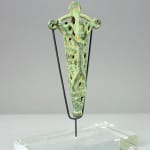Bambara Bronze/Brass Crucifix, 18th Century CE - 19th Century CE
Bronze/Brass
PF.9920 (LSO)
Further images
This beautiful and subtle piece is an encrusted Malian adaptation of a Chrostian crucifix. While most of these pieces are made of wood and considerable larger, this is a small,...
This beautiful and subtle piece is an encrusted Malian adaptation of a Chrostian crucifix. While most of these pieces are made of wood and considerable larger, this is a small, rare, metal variant. The piece has been attributed to the Bambara/Bamana, of Mali, although other such pieces are known for different tribal groups.
The Bambara/Bamana is one of the largest groups in Mali (about 2.5 million) and lives in a savannah grassland area that contrasts strongly with the Dogon heartland. Their linguistic heritage indicates that they are part of the Mande group, although their origins go back perhaps as far as 1500 BC in the present-day Sahara (i.e. Tichitt). They gave rise to the Bozo, who founded Djenne in an area subsequently overrun by the Soninke Mande (<1100 AD). Their last empire – the Mande-speaking Songhai – dissolved in the 1600s, and many Mande speakers spread out along the Nigeria River Basin. The Bamana empire arose from these remnant populations in around 1740. The height of its imperial strength was reached in the 1780s under the rule of N’golo Diarra, who expanded their territory considerably. However, their influence waned in the 19th century and the empire fell to the French in 1892.
Their society is Mande-like overall, with patrilineal descent and a nobility/vassal caste system that is further divided into numerous subvariants of the Bamana state, including the Jula (traders), Fula (cattle herding), Bozo (essentially endentured slaves, carrying out menial jobs) and Maraka (rich merchant class). Unusual jobs are rewarded with caste status, notably historians (Griot), while those whose ancestors were originally slaves to the Bamana (Jongo) have inherited their antecedents’ low status. Age, sex and occupation groups are classed by “ton” – societies that reflect their social importance (age- or sex-related) or work (i.e. hunters, farmers). This complex history is echoed in the systematics of indigenous art traditions. There are four main mask forms, related to the n’tomo, Komo, Nama and Kore societies. Other forms include the famous Chi-Wara headcrest, which was used to encourage good harvests. Heavily encrusted zoomorphic “Boli” figures are also known, along with everyday items include iron staffs, wooden puppets and equestrian figures, which double as accessories for male initiation ceremonies. Their anthropomorphic door locks are especially well-known, and are given to women as wedding presents as they imply fertility with a vertical female body and the “male” bar which slides back and forth.
Christian pieces of this sort are rare as most are still being used.
This is an interesting and attractive piece of Afro-European art.
The Bambara/Bamana is one of the largest groups in Mali (about 2.5 million) and lives in a savannah grassland area that contrasts strongly with the Dogon heartland. Their linguistic heritage indicates that they are part of the Mande group, although their origins go back perhaps as far as 1500 BC in the present-day Sahara (i.e. Tichitt). They gave rise to the Bozo, who founded Djenne in an area subsequently overrun by the Soninke Mande (<1100 AD). Their last empire – the Mande-speaking Songhai – dissolved in the 1600s, and many Mande speakers spread out along the Nigeria River Basin. The Bamana empire arose from these remnant populations in around 1740. The height of its imperial strength was reached in the 1780s under the rule of N’golo Diarra, who expanded their territory considerably. However, their influence waned in the 19th century and the empire fell to the French in 1892.
Their society is Mande-like overall, with patrilineal descent and a nobility/vassal caste system that is further divided into numerous subvariants of the Bamana state, including the Jula (traders), Fula (cattle herding), Bozo (essentially endentured slaves, carrying out menial jobs) and Maraka (rich merchant class). Unusual jobs are rewarded with caste status, notably historians (Griot), while those whose ancestors were originally slaves to the Bamana (Jongo) have inherited their antecedents’ low status. Age, sex and occupation groups are classed by “ton” – societies that reflect their social importance (age- or sex-related) or work (i.e. hunters, farmers). This complex history is echoed in the systematics of indigenous art traditions. There are four main mask forms, related to the n’tomo, Komo, Nama and Kore societies. Other forms include the famous Chi-Wara headcrest, which was used to encourage good harvests. Heavily encrusted zoomorphic “Boli” figures are also known, along with everyday items include iron staffs, wooden puppets and equestrian figures, which double as accessories for male initiation ceremonies. Their anthropomorphic door locks are especially well-known, and are given to women as wedding presents as they imply fertility with a vertical female body and the “male” bar which slides back and forth.
Christian pieces of this sort are rare as most are still being used.
This is an interesting and attractive piece of Afro-European art.
20
of
20





